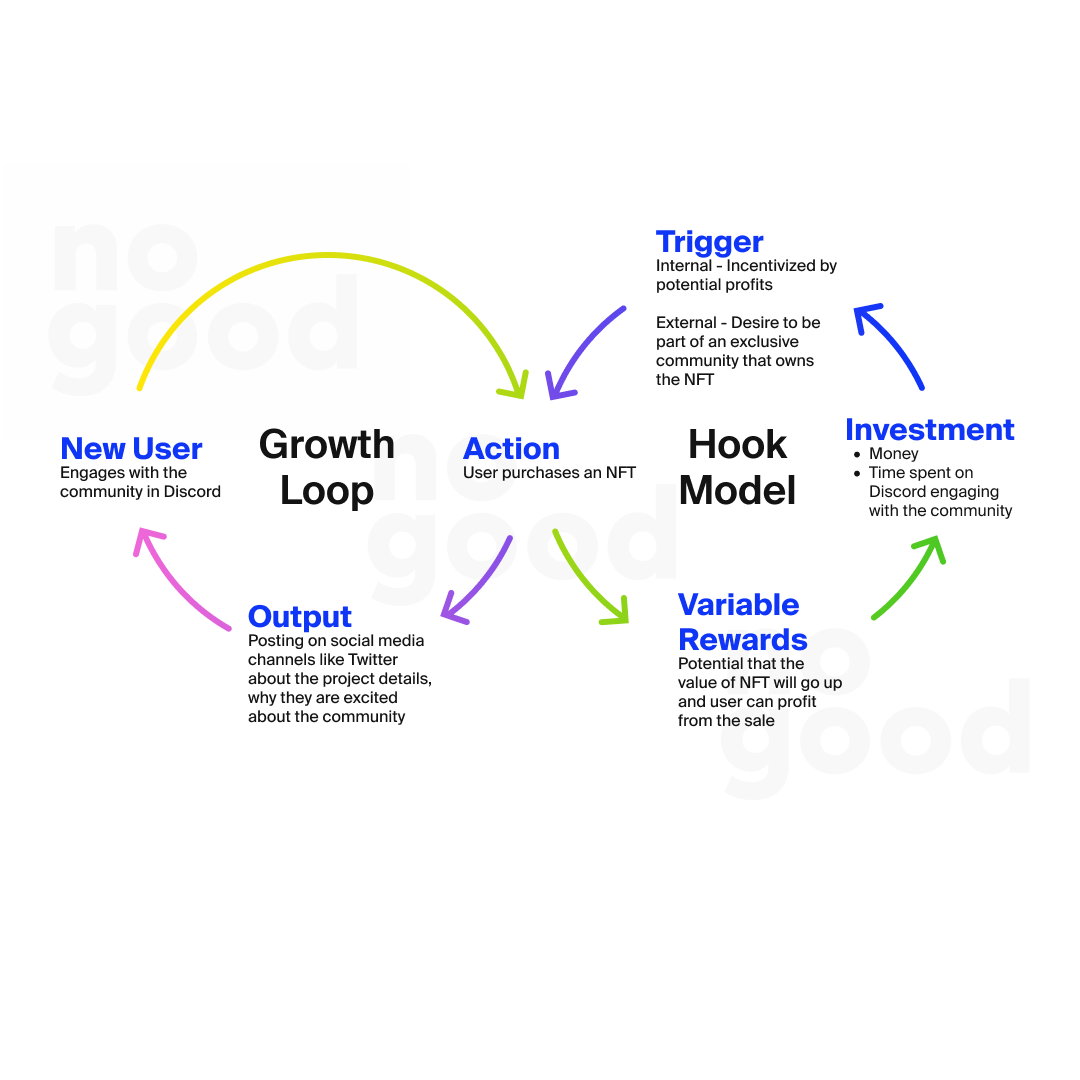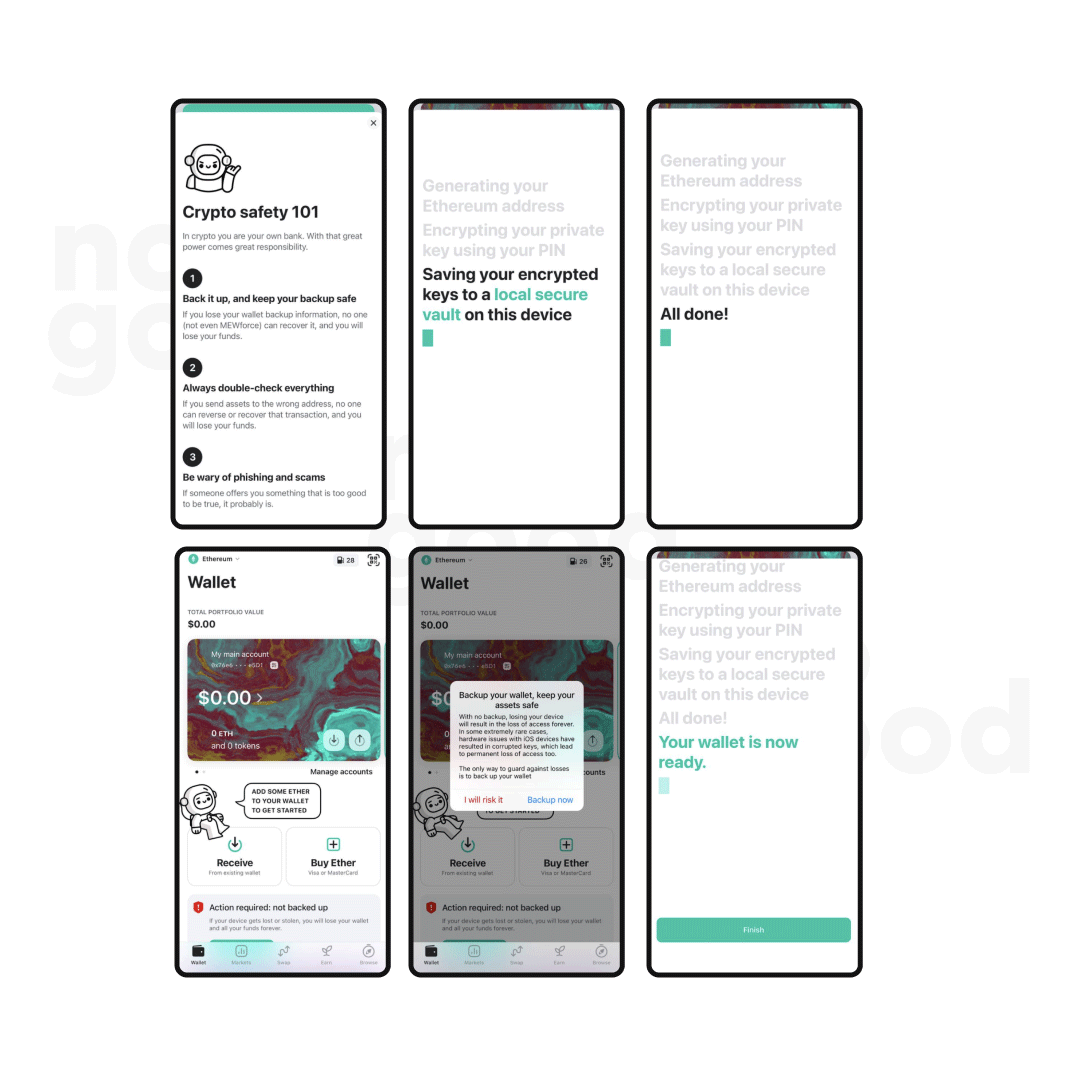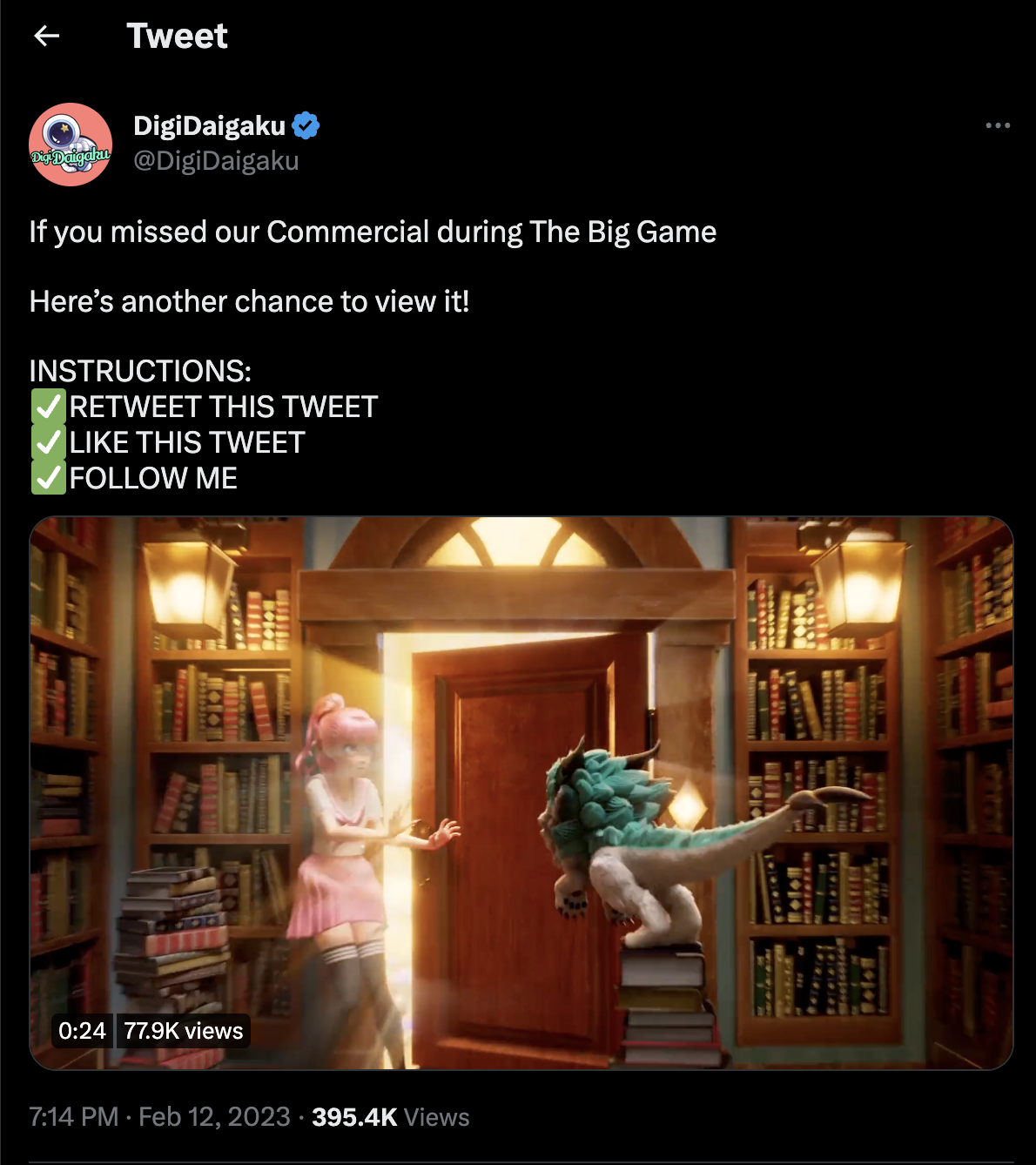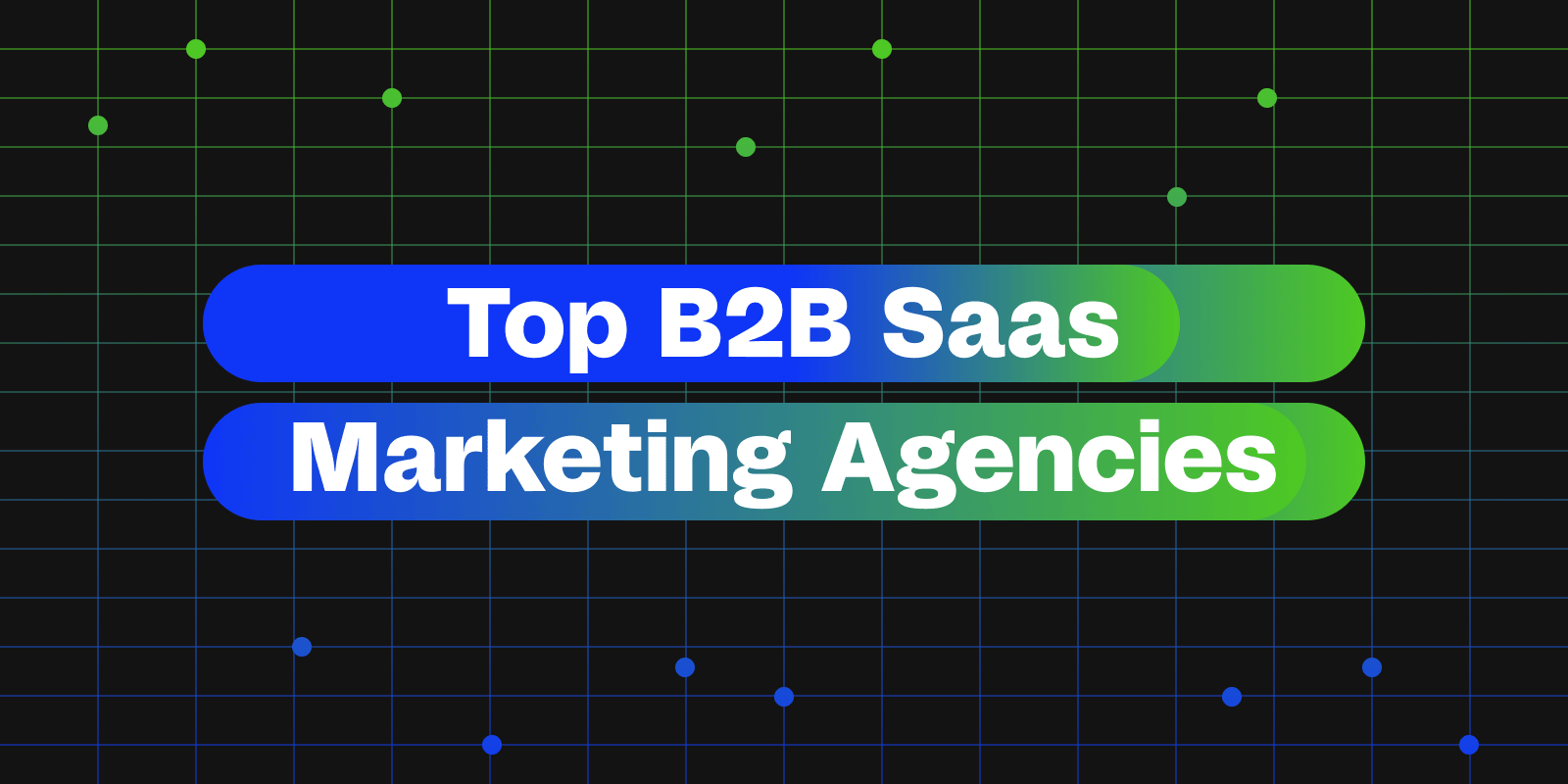With the value of Bitcoin and Ethereum less than half of what it was a year ago coupled with a wave of industry bankruptcies and layoffs, any crypto company even in the green is simply preoccupied with surviving. However, to our surprise, there was one Web3 company that showed up during Super Bowl LVII. DigiDagaku, an NFT-powered game by Web3 gaming company Limit Break, aired a commercial promoting a free mint of its Dragon Eggs collection NFT during the game. By scanning a QR code, viewers could mint one of 10,000 free “digital collectibles” as advertised in the commercial.
Limit Break purchased the coveted 30-second slot for $6.5 million to help onboard players into Web3 and its DigiDagaku game, which is open to holders of the tokens in its collections. However, shortly after airing, it became apparent that the ad was only a part of a quickly developing DigiDaigaku debacle. Apart from how scanning the QR code simply redirected them to the Twitter profile of Gabriel Leydon, the co-founder and CEO of Limit Break, users noticed that the NFT claim itself was only accessible to those who had a crypto wallet — meaning that the greater part of millions of people watching the SuperBowl likely were not able to claim the NFT.
With crypto winter well upon us and many crypto and blockchain companies seeing profound losses in the last year, the argument could be made that such big, flashy marketing spends can wait. However in a time like this during this bear market, Web3 firms face an important question: to pivot or not to pivot? To double down on growth or pivot away?
Onboarding the Next Billion Users for Web3
Growth is necessary for Web3 to advance as an industry. While poorly executed, DigiDaigaku had the right intention of marketing Web3 through the easily understandable gaming medium via mass channels like the Super Bowl, which is screened to 113 million people worldwide – ultimately, with the intention of onboarding users from the Web2 space into Web3. The biggest challenge crypto and blockchain companies face as a whole, and exponentially more so during the bear market, is that everyone in Web3 is trying to access the same, restricted set of users. With a boom in products being built in Web3 and a saturated market where there are only a limited amount of target addressable crypto wallets available, there is no wonder that companies are facing diminishing rates of returns to access these users and the inability to turn profitable.
Web3 as a space has yet to cross the chasm. The argument can be made that all the more so during a time like this Web3 firms need to focus and double down on growth. No one cared about growth in the bull market because everyone was growing due to economic conditions at an unprecedented scale. However, during this bear market growth has stagnated and our vision should be how to onboard the next billion users into Web3. As much as we are marketing our own companies, we all need to be marketing web3 as a whole as that will help to unlock all the growth levers for the space.
How to grow
Here we explore 3 of the biggest levers that Web3 companies can take at this point in time:
1. Focus on your Community. Leverage Community-Led Growth.
With covid exacerbating feelings of loneliness and the rising customer acquisition costs in web2, we’ve seen an exponential shift towards Community-Led Growth (CLG) across the marketing landscape. A sense of belonging is what is at the heart of community-led growth as it fosters humans’ intrinsic need for connection and provides a sense of belonging that brings about value and creation. This is particularly relevant in Web3 since its foundations are highly centered on the values of building, co-creating and fostering a community of builders together.
In fact, community development is at the heart of customer development for Web3 because right now only theoretical markets exist, and communities are the ones that will build these markets. Community needs to come before the markets in the Web3 space because there simply aren’t really any markets. Communities build markets.
Developing a community satisfies a customer’s need for valuable connection by fostering deeper connections that are not simply transactional; rather, community-ed Growth puts the consumer at the center of the brand. In Web3, community development is easily actioned by brands since their communities are actively hanging out and engaging with each other 24/7 through high touchpoint channels such as Discord servers, Twitter spaces and the metaverse. With such high involvement and engagement, “customers” of a Web3 brand view themselves not just as customers, but as members belonging to a community larger than themselves. By ensuring value alignment between the brand, the product and the community, Web3 brands will be able to leverage community-led growth that builds upon their product and harnesses the power of enthusiastic consumers.
With such easy access to their community, Web3 brands can easily leverage this by providing opportunities to deepen the project/brand and user interaction relationship. Through facilitating discussions with real-time support and feedback, creating thought leadership and producing authentic content that is aligned with the brand’s community values, the brand is not only able to iterate quickly based on feedback from the community but communities are also able to bond with each other and identify the pain points they have as a collective that you need to address. This naturally creates an ecosystem that builds your markets. Web3 brands can build successful communities that will funnel users through the growth loop from acquisition to retention.
As such community-led growth strategies can be a powerful growth lever for acquisition, brand equity, trust, and retention in Web3. A brand that is focused on community-led growth can build an atmosphere that fosters these intentions where you are not only focusing on the acquisition of new community members but building a retention flywheel by turning them into loyal customers and brand advocates.

Ultimately, a properly functioning community can self-sustain as it is able to retain existing members and pull in new ones who may or may not have purchased your product. Community-led growth loops also create warm audiences and leads that are more likely to go through each funnel stage, convert, be retained, and advocate on your brand’s behalf. By leveraging ambassadors and advocates within your community, your goal as a Web3 brand is for the community to ultimately become self-managing and self-governing with sustainable growth.
2. Design with the Web2 user in mind to drive Product-Led Growth
Product-led growth (PLG) is a strategy that can be applied to any industry — but it is a particularly strong lever in the Web3 space since user adoption is still nascent in the space and is critical for the success of the industry. Product-led growth focuses on acquiring and retaining customers by creating a product that is so good, customers will actively seek it out and tell others about it, which is exactly the network effect that Web3 brands need for speed to adoption.
One of the main challenges of the web3 space is that it can be difficult for users to understand and interact with decentralized applications (dApps). dApps are a type of software application that is built on top of a decentralized blockchain network and typically requires you to connect your digital wallet to access and use. Unlike traditional applications that are controlled by a central authority or organization, DApps are decentralized and operate autonomously, without any central point of control. With such new concepts, most people at this point of time need to be taught how to use Web3 and simply don’t have a crypto wallet, know how to connect their wallets or how to buy crypto, etc. There is friction to getting into the ecosystem and to overcome this challenge, Web3 startups need to shift their focus from just building products to creating a user-friendly interface that is easy to use and understand.
With the bear market this year, things are bound to be quiet this year. But it is also a great time for people to build out their tech stack and use this year as a restart point for Web3 products to understand how they should better appeal to users not native to Web3. Better experiences and designs will also emerge this year as brands use the downtime and bandwidth as an experimental testing ground to build better products before they hit the masses. Ultimately Web3 brands need to understand a user doesn’t really care about Web3 when they’re new to the space. Use blockchain to power the product but we need to think about designing experiences that strip away as much jargon and complications as possible to reduce friction that is involved in using such decentralized applications. This can also be achieved by using design patterns users are familiar with in Web2 and providing clear instructions.

Source: MEW Wallet ensures they appeal to Web2 users by simplifying onboarding into 3 simple steps while explaining the importance of safety and educating users on what they’re clicking on and signing at every step of the user journey. Guidance throughout the onboarding process is also clearly provided coupled with clear CTAs.
3. Find the right time to layer on paid strategies
While community and product-led growth is really great at the beginning stages for a Web3 brand to build that trust, confidence and establish their brand presence, after you get to a certain point, that channel will saturate. As such, once that trust and credibility have been built, Web3 brands can layer on paid media on top of this but it’s all about the timing which will make or break the brand.
In the Web2 world, companies can typically immediately drive growth with paid marketing by driving paid traffic directly to their landing page. This timing and strategy are different from that of Web3 brands as the marketing funnel for Web3 looks different. With Web3 the funnel looks very different and ends up very much being cross-platform – Twitter at the top, Discord in the middle and on-chain apps at the end of the funnel. This means Web3 is very much about engagement on the right channels because you need to meet people where they are and this will typically not be on your first-party application. Web3 brands need to focus on building their communities first to drive their product growth, before traction comes and companies can be ready to pour fuel on the fire with more performance and cost-per-acquisition style marketing to get to the next level of growth.
Also, good Web3 marketing simplifies and showcases. If we want to onboard the everyday Web2 user, we can’t expect our communities to only consist of degens that spend 9 hours a day in discord. Web3 brands need to not only educate users but make their content more snackable. This can come in the form of short-form videos, carousels and even infographics. With such a strong community at their fingertips, Web3 startups should also leverage their communities to help promote their product. The Web3 space is built on a culture of collaboration and community. Encouraging user-generated content, such as tutorials and educational resources, can help build a community around your dApp and drive growth. This can be further incentivized by getting users to create content in exchange for tokens or access to premium features.
The most important year of Web3 to date will be this year. This is the year when Web3 brands should be doubling down and investing in long-term strategies that will bring about sustainable growth. Web3 might go quiet this year but it is a great time for a lot more experimentation and internal building. While it might not look crazy on the outside like it did in 2023, this is the time Web3 brands should be investing in growth and experimenting with interesting new tactics and channels to see what works ahead of the next bull market. So that when the time comes, they have all these learnings and a playbook for sustainable and measurable growth with which they are now ready to pour fuel on the fire as that all comes into place.







